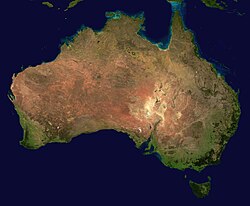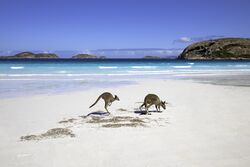See all articles relating to: Australia

Australia, a diverse and historically rich continent, is situated in the Southern Hemisphere between the Indian and Pacific Oceans. Its original inhabitants, the Aboriginal peoples, have lived on the land for over 50,000 years, preserving their deep connection to it through their enduring cultural traditions. European exploration of the region began in the 17th century, with Dutch explorers sighting the western coast. However, it was Captain James Cook, a famous British explorer, who significantly contributed to Australia's history. Cook mapped the eastern coastline during his first voyage between 1768 and 1770, paving the way for future exploration and colonization. His discoveries ultimately led to the establishment of the first permanent European settlement in 1788, when the First Fleet arrived at what is now Sydney.
Over the next century, Australia experienced rapid expansion and development, propelled by the mid-19th century gold rush that attracted migrants from across the globe. In 1901, the six British colonies united to form the Commonwealth of Australia, marking a significant milestone in the nation's political evolution. Today, Australia's unique identity is a testament to its Indigenous roots, colonial past, and geographical location, offering a fascinating blend of ancient traditions and modern cultural influences.
The regions of Australia
Australia is divided into six states and two major mainland territories:
States:
- New South Wales (NSW)
- Queensland (QLD)
- South Australia (SA)
- Tasmania (TAS)
- Victoria (VIC)
- Western Australia (WA)
Territories:
- Australian Capital Territory (ACT)
- Northern Territory (NT)
Australian history
See: Australian history
Australian geography
See: Australian geography
Researching family history in Australia
See also:
- Australian genealogy
- Birth, death, and marriage records in Australia
- Australian electoral rolls
- How to cross-reference Australian resources
- Australian immigration
- Australian emigration
- Australian archives
- Vital records in Australia
- Census records in Australia
- Civil registrations in Australia
- Church records in Australia
- Newspaper records in Australia
Australian ethnicity

Australia is a multicultural nation, home to a rich tapestry of ethnicities that contribute to its vibrant cultural landscape. The Indigenous peoples, comprising Aboriginal and Torres Strait Islander communities, represent the original inhabitants of the continent. European settlement, primarily from Britain and Ireland, has played a significant role in shaping Australia's demographics. Since the mid-20th century, Australia has welcomed an influx of migrants from diverse backgrounds, including Italians, Greeks, Lebanese, Chinese, Vietnamese, and Indians, among others. These varied ethnic groups have contributed to Australia's unique blend of cultural traditions, customs, and cuisines, making it a truly diverse society.
See also:
Australian surnames

The country's diverse population, resulting from British colonization and subsequent waves of immigration, has led to a wide range of surnames reflecting various cultural backgrounds. For example, while British and Irish surnames are predominant due to historical settlement patterns, the presence of Italian (e.g. Rossi), Greek (e.g. Papadopoulos), Chinese (e.g. Wong), and other non-Anglo surnames reflects Australia's multicultural fabric. Understanding the origins and meanings of these surnames can assist researchers in identifying family connections, geographical origins, and even occupations, enhancing their understanding of their ancestral past
See also: